Friday, October 31, 2003
Tomorrow morning we're heading to Durham, New Hampshire, where Gene Robinson will be consecrated Bishop of New Hampshire on Sunday. J. and I are doing a photo-essay project on the transition and consecration, and all the attending controversy (I love how the British say "conTROversy). I've never experienced quite this mixture of joy, liberation, pain, sorrow, upheaval, beginnings and endings all twisted together around an institutional event. None of us know quite what will happen on Sunday. Those of you who pray - please pray for all of us.
On Monday, insh'allah, we will head up to Montreal for a week of vacation, regrouping, and editing time. I plan to be blogging at least intermittently, so please keep checking, and I hope to post my impressions of the consecration, as well as a piece for tomorrow's Ecotone topic, "Coffee Shop as Place". If you'd like to join in, just post a link to your response at the Ecotone Wiki.
Happy Halloween/All Hallow's Eve!
9:02 PM
|
Thursday, October 30, 2003
It's a half-hour of in-between time; I just finished changing my clothes so I can go out tonight, my work is done enough that I can leave, but there's twenty minutes before I need to. It's a quiet evening here tonight, dark early because of the time change, cool but not cold. This room is bright with warm incandescent light on books and wood and the red rug, but I stood for a few minutes in the window, looking out at the night beginning to fall over the village. The tree branches are mostly bare now, stretching their twiggy fingers against the sky, more themselves than ever. How do trees have so many branches, and sub-branches, twigs and twiglets? So many leaves, now fallen, so many buds already beginning the long wait that will take them through frost and snow and the icestorms of early spring to become the next crop of leaves. The trees are beautiful tonight: silent, inky black, dignified. The sky -- a perfect bowl of liquid light, without a single wisp of cloud, shading from deepest blue at the zenith, to apricot, to rose. There is the moon, a waxing crescent, and reddish Mars, in the east; the trees, mostly maples and oaks, a Norway spruce all the way across the block, in silhouette; the white-clapboarded houses; a picket fence; a neighbor's porch-light spilling onto his yard, shining the fat pumpkin on the porch steps. Not much traffic, no children, no cats. Just quiet, waiting.
5:33 PM
|
Wednesday, October 29, 2003
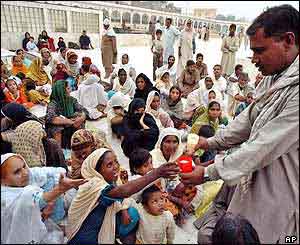
Poor people in Lahore, Pakistan, use handouts of milk to break their Ramadan fast. From "The Day in Pictures" at the BBC.
RAMADAN MUBARAK, RAMADAN KAREEM
At our interfaith gathering today we talked about Ramadan. I asked my Arab-speaking Muslim friends a question I'd been wondering about: when do you say "Ramadan Mubarak" and when do you say "Ramadan Kareem", since people (both in person and in the comments here) had used both. They told us that the word "mubarak" is used in a congratulatory sense for many occasions - a wedding, a birth - as well as for Ramadan. It's a general greeting for good wishes. "Kareem" has more of a meaning of "blessed", so if you want to say something a bit more religious, wishing someone a "blessed Ramadan" rather than just a "happy" one, you'd use "kareem".
One of my friends also spoke about taqwa , which is the state one wishes to be in as he or she approaches God during Ramadan. He remarked how difficult this word is to adequately translate into English, and later wrote me an e-mail that suggested "a state of wonder, dread, and reverence" all at once. He's right - this is untranslatable with a single word, although "awe" probably comes closest - but what a powerful concept.
There was a new couple with us today. Both had spent much of their adult lives in the Middle East. B. had lived in Afghanistan for 22 years, and I. had taught English in Turkey, Iran, the UAE, and Pakistan. I noticed that when B. spoke about Ramadan, she said "Ramzan". Nancy Gandhi, at Under The Fire Star in Chennai, also had a post recently about Ramadan on the Indian subcontinent, and my intrepid friend LanguageHat then explained the D/Z thing. Take a look, it's fascinating.
4:12 PM
|
Monday, October 27, 2003
SOME RECOMMENDED LINKS
 qB at FrizzyLogic has an excellent recent post going into greater depth about Kandinsky and the reasons for his sensitivity to other art forms: qB at FrizzyLogic has an excellent recent post going into greater depth about Kandinsky and the reasons for his sensitivity to other art forms:
Kandinsky had a form of synaesthesia, specifically, the neurological condition where sensory input to one sense also produces a response in another sense. In his case, seeing sounds, for instance music, as colours...
 A very different take on the moon from Tony Anthony at Beneath Buddha's Eyes (post of Oct 20) A very different take on the moon from Tony Anthony at Beneath Buddha's Eyes (post of Oct 20)
 Conscientious linked to Susan Sontag's acceptance speech for the Friedenspreis des Deutschen Buchhandels (the Peace Prize of the German Book Trade). I've read far less of Sontag's oeuvre than I'd like to admit, but I admire her writing and thought a great deal. This speech, about the "great divide" between Europe and America, is really an essay that touches on some of what we've been discussing here, especially the links between literature and activism; it's well worth your time. Conscientious linked to Susan Sontag's acceptance speech for the Friedenspreis des Deutschen Buchhandels (the Peace Prize of the German Book Trade). I've read far less of Sontag's oeuvre than I'd like to admit, but I admire her writing and thought a great deal. This speech, about the "great divide" between Europe and America, is really an essay that touches on some of what we've been discussing here, especially the links between literature and activism; it's well worth your time.
A good deal of my life has been devoted to trying to demystify ways of thinking that polarize and oppose. Translated into politics, this means favoring what is pluralistic and secular. Like some Americans and many Europeans, I would far prefer to live in a multilateral world --- a world not dominated by any one country (including my own). I could express my support, in a century that already promises to be another century of extremes, of horrors, for a whole panoply of meliorist principles --- in particular, for what Virginia Woolf calls "the melancholy virtue of tolerance..."
The writer in me distrusts the good citizen, the "intellectual ambassador," the human rights activist --- those roles which are mentioned in the citation for this prize, much as I am committed to them. The writer is more skeptical, more self-doubting, than the person who tries to do (and to support) the right thing...
A writer, I think, is someone who pays attention to the world. That means trying to understand, take in, connect with, what wickedness human beings are capable of; and not be corrupted --- made cynical, superficial --- by this understanding.
-- Susan Sontag
 And finally, the culinarily-adventuresome should not miss Mary's answer to my question of "what is Kedgeree..." -- her recipe is at Mint Tea and Sympathy And finally, the culinarily-adventuresome should not miss Mary's answer to my question of "what is Kedgeree..." -- her recipe is at Mint Tea and Sympathy
8:15 PM
|
Ramadan Mubarak to my Muslim friends and readers.
The Cassandra Pages had a banner week last week, with a record number of comments, in particular. I also had some off-blog correspondence with readers, one of whom brought up my previous comment about not wanting to talk about politics on the blog, and I wanted to elaborate on that a little.
Prior to starting this blog in March, 2003, I had spent much of the previous 2 1/2 years writing about politics and working on peace and justice and anti-war efforts. I ran an e-mail listserve about Middle Eastern politics and American foreign policy that attempted to provide background, historical information, and some cultural and religious understanding in addition to a weekly editorial commentary and links to the best articles that week from the world press - especially including articles from non-Western sources. This was a pretty consuming task, in addition to my professional work, but I loved it. I was also organizing and leading a monthly interfaith gathering for prayer and discussion (which I still do), and participating in Women in Black, and going to many, many lectures, films, demonstrations...
But after the war in Iraq and the triumphalism of the Right, and blindfolded acceptance of administration policies by so much of the population here in America, I began to burn out. My views didn't change, of course, but I had to take a break. and I also needed to step back and ask what was happening to me - what was my responsibility to my own gifts that I had pressed into political service, but which were really meant for other areas of endeavor? I hadn't written a poem or personal essay that wasn't political in two years. I hadn't made a painting or done a drawing. I needed to try to rediscover my own center and recharge myself, find some joy in the middle of so much world pain. I was depressed, discouraged, frustrated, and I needed to take care of myself.
To some extent that meant going deeper, not escaping, although trying to escape was always tempting.( I recognized that real escape was impossible.) I wanted to get back to my own touchstones of art, literature, music, and nature, and to writing about the human spirit in relationship to those things. When I eventually started the blog and saw it begin to take shape, I gradually realized that this kind of work is crucial for my own emotional and intellectual health, but it's also another way to be political. Our ignorance of one another leads both to self-centeredness and arrogance; it breeds fear, and fear breeds violence. Building cultural bridges, opening up opportunities for dialogue, and concentrating on what we all share as human beings, rather than what divides us, is essential not only for our own souls but for the future. The lessons I'd learned doing interfaith work could be expanded into a larger sphere.
The flurry of passionate, searching comments last week indicates to me not so much that we need to talk politics, per se, as that many of us need to talk about how to protect our own tender, hurting spirits while discussing what we can do to be compassionate, creative, engaged members of the human race. I have no problem discussing that here; I just don't want to use this space to do what I was doing before - political reportage and specific commentary - others are doing that very well. Please feel free to say whatever you want to in the comments, however. I don't want to censor what is said there - within reason, of course! - and I actually feel honored that the discussion of late has been on such a high level. We have an international community of readers here, and that's part of the beauty of it - we need to be able to share our perspectives openly and learn from each other and I'm very grateful for your participation.
"Do what you can, with what you have, where you are." -- the current "thought for today" from the spirituality section of The Times of India.
10:31 AM
|
Sunday, October 26, 2003
THE NEW MOON and RAMADAN
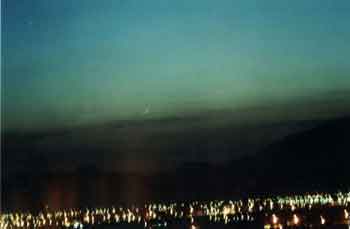
Crescent Moon over Iran.
Photo by Reza Amirzadeh of a 27-hour-old moon, taken last October.
As you'll read in yesterday's post, Ramadan will begin soon. If you're interested in how the sighting of the new moon is calculated, here is a website that has lots of details about it. There's also a lot of other information, such as "what does the Qu'ran say about the moon?" and "What does the Qu'ran say about astronomy?" We owe a great deal of our early knowledge of astronomy to Arab and Islamic astronomers, whose interest in studying the heavens was motivated, at least in part, by the Qu'ran itself.
"In the creation of the heavens and earth, and the alternation of the night and day, and the ships which sail the seas to people's benefit, and the water which Allah sends down from the sky -- by which He brings the earth to life when it was dead and scatters about in it creatures of every kind -- and the varying direction of the winds, and the clouds subservient between heaven and earth, there are signs for people who use their intellect." (Qu'ran, Sura 2:164)
12:29 AM
|
Friday, October 24, 2003
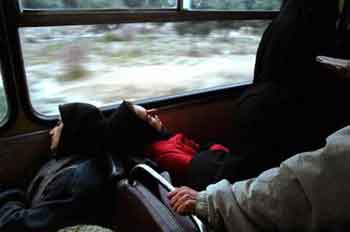
A photograph by Farzanah Khademian from Iran Journal of Photography
I bought my first pomegranates of the season today. They're sitting in a dark blue bowl across the room, exuding red. I can feel their heaviness from here, that heft that betrays the hidden interior, a room of dark crimson liquid, jewel-like seeds.
Pomegranates are associated, in my mind, with Ramadan, which will most likely begin this weekend with the first sighting of the new moon. Whenever I see that little sliver of crescent moon I think of it as a Ramadan moon, and feel affectionate toward my Muslim friends for whom it means so much, and holds so many memories. I've been fortunate to be invited to share some of the joy of this season with my friends over the past few years. Christians tend to think of Ramadan like Lent: a month of repentance, prayer and very difficult fasting - from sunrise to sunset every day. But for Muslims, I sometimes think it is more like a month-long celebration than a marathon, because they accept the challenge with such joy. Most Muslims seem to love Ramadan and look forward to it, even though the fasting can be difficult, because they feel it is the time when they draw closest to God, and when prayer is particularly acceptable and welcome to Him. They look forward to breaking the fast - to Medjool dates, and pomegranates, and special sweets, and meals with extended family and friends. Here, on the frontiers of Islam, I've watched my friends try to recreate something like the celebrations they remember from their native countries and childhood, improvising as best they can, gathering together a disparate group of people united only by their faith tradition, trying to find and invite every last Muslim in the area who might be feeling lonely or isolated from their family and culture. Their eyes glow as they tell of how they celebrated Ramadan as children: what it felt like, what it was like the first year they were allowed to fast. And I've participated in some events where the Muslim community has reached out to the community at large, inviting them for a Ramadan meal and some story-telling about a heritage that is central to at least one-sixth of humanity. These things give me hope.
7:34 PM
|
Thursday, October 23, 2003
KANDINSKY AND SCHOENBERG
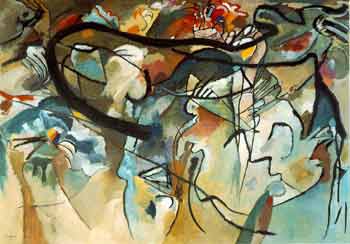
Composition V, 1911, by Vassily Kandinsky
"Today's dissonance in painting and music is merely the consonance of tomorrow." --Kandinsky
A good article about Vassily Kandinsky and Arnold Schoenberg, two prophets of modern art, is in today's New York Times, in conjunction with a new exhibit at the Jewish Museum.
"After finishing his painting, Kandinsky dashed off a breathless letter to Schoenberg in Vienna. "You don't know me," he wrote, but "what we are striving for and our whole manner of thought and feeling have so much in common. . . . The independent life of the individual voices in your compositions, is exactly what I am trying to find in my paintings..."
10:20 PM
|
SNOW!
I couldn't believe my eyes when I got up this morning, and saw thick, wet snow covering the junipers and barberries and blanketing the lawn. It was all gone by 10:00 am, but the sky has been "spitting snow", as they say up here, all day. I'm not ready! There are bags of tulip bulbs waiting for my attention, and a vegetable garden to clean up, peonies to cut off...not to mention a million other tasks that have been languishing for the past month. Well, I'll get to the tulips, and if the gardens don't get straightened out until spring, it will be all right. Part of the joy of living in New England is the unpredictablility of the weather.
For here it is, nearly Halloween - All Hallow's Eve - and All Saint's Day. Our celebration of the latter is taking place this coming weekend, a week early, since our choir and many parishioners will be at Bishop-elect Gene Robinson's ordination on November 2nd. For All Saint's, we always sing a Requiem, with each part of the mass sung, as originally intended, in the correct place in the service, unlike a concert performance. Last year we did a modern Requiem by the British composer John Rutter. This year, though, we're doing the Mozart. Tonight is our last regular rehearsal, and Saturday morning we'll be rehearsing with orchestra. I look forward to the rehearsals and the performance with happiness; one of the great pleasures of my life is singing in this choir and getting the chance to learn and perform such wonderful music.
6:42 PM
|
I've just updated my Book Notes.
8:56 AM
|
Wednesday, October 22, 2003
TWO POEMS
written in autumn by Anna Akhmatova (1889-1966)
"Four Seasons of the Year"
I will return today
To where I was in spring.
I'm not grieving, I'm not angry,
And only darkness accompanies me.
How deep it is and velvety,
Above all, always familiar to me,
Like the leaf falling from the tree,
Like the wind's lonely keening
Over smooth ice.
October 12, 1959, Moscow
"Creation"
...it says:
I remember everything simultaneously;
Like the distant beam of a distant lighthouse.
I carry the universe before me
Like an easy burden in an outstretched palm,
And in the depths, mysteriously growing, is the seed
Of what is to come...
November 14, 1959, Leningrad
3:42 PM
|
Monday, October 20, 2003
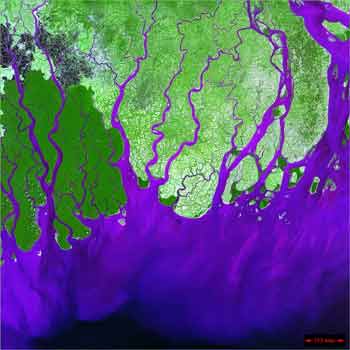
The Ganges River Delta. Landsat image from earthasart, via Fragments from Floyd
I'm very moved by the discussion that's going on in the comment thread about how to live in such a broken world. The last comment I read before writing this post was by Dale, who wrote about his practice of Tong Len (the Thich Nhat Hahn meditation I mentioned - thanks for the name, Dale), and how difficult it is. I agree. I also agree that we must try -- try to love and not hate, try consciously not to become poisoned by that which we despise.
I believe that we always have a choice about our attitude, about how we are going to approach any given situation in which we find ourselves. The people I admire the most are the ones who manage to find joy no matter what, the ones who are able to keep on loving and keep on giving hope to others. These extraordinary people weren't born that way - they worked on themselves consciously to transform their own hearts. We find examples in every religion and every culture, famous and unsung people alike. Many of us have known them personally too. Even as I fall far short, I hold this as a goal for myself - to be like that as much as I can, and to use my life to learn these lessons. Over time, we make progress. I can testify to that! I'm a different person now, at fifty-one, than I was at thirty. I hope I have enough life ahead of me to stay in the refining fire and continue to learn and grow.
Who do we really want to be? What kind of person, holding what in our heart? Maybe growing up during the cold war made my choices more sharp-edged: I was a little kid, all the adults around me were scared to death that we were all about to be fried, and none of these people I trusted with my life could offer me any real reassurance. I think I decided then that I was going to live as though there was a tomorrow, as though there was hope, because I couldn't live believing only in disaster and despair. Today the world is going through a crisis where violence and greed seem to have the upper hand, to be unstoppable. If we look through another, related lens, it seems as though human beings really may make the planet uninhabitable - surely, it could happen. 9/11 shattered our last illusions, our naive belief that everything is all right. But what am I going to do, in the face of that? Adopt a nihilistic philosophy? Live only for myself and my selfish desires? Crawl under a rock and cry until it's over? None of these are viable options for me, because I see all life as interrelated. Whatever I choose will affect others. My nihilism, hatred, or despair will infect those around me. On the other hand, if I choose love and hope, my world is transformed, and so is the world around me. This is not an abstract idea, it's real. Our choices and our attitude affects far more than we think, but it starts in small concentric circles, like a single raindrop falling into a pool.
Not-hating doesn't mean not being angry. Non-violence does not mean allowing yourself to become a victim, a doormat for greed and corruption. What I want to avoid is the hardness of heart that I've seen infecting the peace movement at times, where anger and frustration turn well-intentioned people into beings who are anything but peaceful: fighting among themselves, indulging in self-destructive behavior, and even turning to violence. But finding a path through these turbulent waters is very difficult: that's why disciplines such as meditation, prayer, or specific contemplative practices are so helpful. They hold up a mirror for us so that we can see the traps we may have fallen into in our thinking.
For each one of us, I think there is a door that leads to liberation. For one, it may be nature. For another, music, writing, or some other creative expression. For another, the love of family, or working with children or the elderly. We need to find what it is that brings us out of ourselves and renews us, gives us hope. What is our "well"? And we also need community, because this is too hard a path to travel alone.
6:23 PM
|
Sunday, October 19, 2003
THANK YOU
I want to thank all the people who have been commenting on recent posts. Not only have you had a lot to say, but you encourage me to continue what I'm doing here, and that's very important to me. Maybe it doesn't seem like I could be at a loss for either words or motivation, but guess what - both happen. This is a partnership, as all writing and art is. We need one another. I am very grateful to hear from you, and I'd like to encourage those who read but seldom (or never!) write to send me a comment or an email. Please tell me what you like or don't like; tell me why you read this blog and what you're doing in your own life that's related to what we discuss here.
COMPASSION MEDITATION
Miguel wrote in a recent comment, and elaborated on his own blog, that he feels he has fallen into the trap of "hating", of having visceral negative feelings toward some of the people he holds responsible for current world crises and suffering. First, I'd like to say that if we're honest, most of us have these feelings - no matter how outwardly committed we may be to non-violence, peace movements, interfaith dialogue, or the like.
Once we recognize and admit that we have these negative feelings, though, we often feel consumed with guilt, or helpless in the face of them - are "we" just like "them"?
I found a useful practice some years ago in another book by Thich Naht Hahn - sorry, I can't remember which one. It's helped me deal with these negative feelings, and maybe others will find it useful.
Sit comfortably, and concentrate on your breathing for a few minutes to come to a calm state. Now, think of a person for whom you have genuine and easy love and affection. Feel the mutual love you share. Now, with each outward breath, send that person your love and good wishes. Meditate on this person and your relationship for a few minutes, always sending them your good will and wishes for their peace and happiness.
Now, move in your thoughts to a person for whom you feel neutral, or indifferent. Do the same thing. With each outward breath, send that person your good will. Feel yourself come into relationship with them, even if this is not possible in real life. Wish their happiness and well-being.
Now, focus on a person who it is very difficult for you to like, for whom you may even have feelings of hate. With each outward breath, send them peace, and wishes for a change of heart. In good will, meditate on this person, wishing for them the same openness and spirit as the person who it is easy for you to love. Do this for a few minutes.
I've found that this meditation works, in that it changes me. In Christianity we are taught to love our enemies, and told to pray for them. In Buddhism, we are expected to have compassion for all sentient beings - no exceptions. When we imagine a world where all of us are able to pray or meditate, with an open heart, for everyone else, we can see that this world would be quite different from teh one we inhabit. Peace begins with each of us. We don't have to like our "enemies", but when we allow them to enter into our hearts in the same way our friends, something happens and we cannot see them with the same solid detachment. In this practice, we also discover our own capacity for love. We are able to see ourselves as loving people, not haters, when we do a practice that is parallel for different people in our lives, and we are able to work on ourselves and notice change over time as our hard hearts become softer.
Maybe we need to ask why some people seem to be filled with love, while others cause untold suffering. The answer is that the latter type of person is completely out of touch with the true ground of their being. They do not understand what we are doing here on earth, what human life is about. This is the ultimate tragedy, and it's natural for us to hate them and revile them because they are causing huge harm. But it's very important not to get stuck there, because the negative energy of such people creates a reaction within us that perverts our sense of connectedness and breeds equal but opposite feelings of hatred, confusion, and depression in us. The only way to heal hatred in the world is through love. Listen to Desmond Tutu - he says this over and over again. So do other genuine spiritual leaders. We need to begin by confronting the seeds of hatred and negativity in ourselves, and start transforming them.
7:27 PM
|
EVOLUTION OF ALPHABETS
Fascinating - I can't vouch for its accuracy, but the concept here is very interesting. via Conscientious.
6:14 PM
|
Saturday, October 18, 2003
INTERVIEW with poet Nick Piombino, author of Confessions of a Blog Artist at sidereality (via wood s lot)
What I want from my experience of writing is to discover what I want from life and writing and what I want to have with and from others. Not to proclaim it: to discover it. It goes without saying that approaching art this way means keeping this an open question. This is difficult living in a culture like ours, but not impossible, with more than a little help from my friends.
I just realized that what you are getting at about objects also has to do with the idea of the materiality of the "book" and how that connects with materialism. I have always been troubled by the materialistic aspect of culture and the whole book culture, and the culture of competition and the frequently artificial creation of reputations is part of all of this...[read more]
9:01 AM
|
Friday, October 17, 2003
WHAT BOOKS?
People have asked, OK, so what books did you buy yesterday?
Two books: Living Buddha, Living Christ, by Thich Nhat Hanh, and Branching Streams Flow in the Darkness, by the late Shunryu Suzuki. I've been wanting to own the former for a while, and was delighted to find the latter, since Shunryu Suzuki's famous Zen Mind, Beginner's Mind was a seminal book for me. I didn't know anything else of his had been collected or published, but there were two relatively new books in the store, both posthumous collections of Suzuki's dharma talks and sandokai (question-and-answer sessions). More on Branching Streams soon, I'm sure.
For now, here is the beginning of Living Buddha, Living Christ:
Religious Life is Life
Twenty years ago at a conference I attended of theologians and professors of religion, an Indian Christian friend told the assembly, "We are going to hear about the beauties of several traditions, but that does not mean we are going to make a fruit salad." When it came my turn to speak, I said, "Fruit salad can be delicious! I have shared the Eucharist with Father Daniel Berrigan, and our worship became possible because of the sufferings we Vietnamese and Americans shared over many years." Some of the Buddhists present were shocked to hear I had participated in the Eucharist, and many Christians seemed truly horrified. To me religious life is life. I do not see any reason to spend one's whole life tasting just one kind of fruit. We human beings can be nourished by the best values of many traditions.
Professor Hans Kung has said, "Until there is peace between religions, there can be no peace in the world." People kill and are killed because they cling too tightly to their own beliefs and ideologies. When we believe that ours is the only faith that contains the truth, violence and suffering will surely be the result. The second precept of the Order of Interbeing, founded within the Zen Buddhist tradition during the war in Vietnam, is about letting go of views: "Do not think the knowledge you presently possess is changeless, absolute truth. Avoid being narrow-minded and bound to present views. Learn and practice nonattachment from views in order to be open to receive others' viewpoints." To me, this is the most essential practice of peace.
I wrote a long piece about the current debate within Anglicanism, but decided not to post it, because I don't want to engage in political debate in this blog. However, I do want to say I am appalled and saddened by the conservatives who threaten to walk away over the issue of ordaining a homosexual bishop who is honest enough to admit his orientation and lifestyle.
None of us knows the whole truth. Until we die, our choice here on earth is to love one another, or to be divided: Jew against Muslim, Sunni against Shiia, Catholic against Protestant, Anglican against Anglican, atheist against believer. I wish we could all take Thich Nhat Hanh's words to heart.
5:08 PM
|
Thursday, October 16, 2003
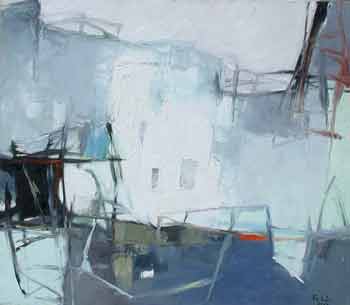
Autumn in Hanoi by Pham An Hai, 2003, oil on canvas, 70 x 80 cm
from Contemporary Art in Vietnam, via plep
Autumn in Hanoi looks beautiful but cold. Autumn in New England has been magnificient. And, sadly, it is ending. Last night we had a rushing gale that shook the windowpanes with wind and lashing rain, and this morning, when the skies cleared, many of the leaves were on the ground. Late in the afternoon I drove north, taking in the last of the spectacular scenery: deep blue mountains in the east outlined against a grey sky below white clouds, with blue patches and a brilliant sun in the west; fields of intense chartreuse; trees of orange, red, and gold; the river reflecting the drama of the sky. I was filled with many thoughts as I drove, and although the scene was breathtaking, I didn't feel peaceful. For some reason I decided to drive two more exits north and then turned around in a small village (by small, I mean a general store/post office and five or six white-framed houses, with hardly a cup of coffee to be found). I stopped the car, tried to make a phone call ("No Service", the cell phone screen informed me), and turned around. Heading up the hill out of town back toward the interstate, I saw a small sign: "Meditation Cushions and Gifts". There is a Tibetan Buddhist monastery in a nearby town, and part of my brain had considered stopping there, but I didn't have time. I did, however, have time for a look at this store, so I turned around again. As soon as I pushed the door open and heard the tinkling of the temple bell, I knew it was a fortuitous decision. The store was bright, filled with the smell of sandelwood incense and the sound of running water from a little fountain. Cleanly handmade shelves of light pine held teacups and pots in celadon and blue, brass incense burners and bells, brocade runners and garments, meditation beads, incense, sumi calligraphy supplies, music, the company's signature zafus (meditation cushions). And arrayed on tall shelves all along the back wall were hundreds of books on Buddhism, meditation practice, and related subjects. I browsed for a while while conversation drifted in from the zafu production crew working in an adjoining room, and finally went to the counter with two books.
I headed back onto the highway through two slanting, towering cuts of black shale that I had drawn from memory in charcoal many years ago; they had seemed then, and seemed again today, to represent the psychological walls we sometimes face in life: walls that Buddhism showed me were of my own construction. How curious that this unexpected discovery had turned into the destination of my journey today! My own zafu had come from this place, by mail order, years ago, and it seemed that I was being told, gently but firmly, that perhaps sitting back down on it might be a good thing to do right now.
7:51 PM
|
Wednesday, October 15, 2003
This is a contribution to the ECOTONE Topic for today, "Place Names".
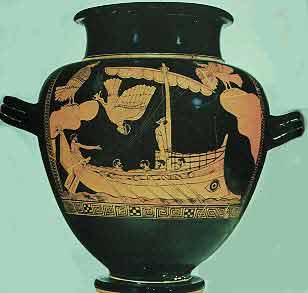
Odysseus lashed to the mast while tempted by the Sirens (on a red-figure vase in the British Museum)
PLACE NAMES
Listening with rapt attention to my mother reading a child’s version of The Iliad and The Odyssey, I couldn’t have predicted that the nine-year-old girl I was then would grow up to study classics – or, for that matter, give a “virtual place” someday the name The Cassandra Pages. Place names are supposed to tell us something about history, but how often does our own history get caught up in theirs? In my case I think it did, to some extent, giving me a tacit permission to do something out-of-the-ordinary with my life, and to identify with a history that went even further back than the colonial and Indian names that also made up the map of my childhood world.
It’s impossible to ignore the native American legacy in central New York. The beautiful Iroquois names that trip musically off the tongues of local people and confound newcomers -- Susquehanna, Chenango, Unadilla, Chittenango, Canasawacta, Oswego, Sacandaga, Canajoharie, Skaneateles (give up? you say “skinny-AT-las”) – are just one part of a local culture that has never moved very far away from woodsman lore and craft, hunting and fishing for food more than sport, and interest in early history, artifacts, and antiques.
The Dutch colonists gave their own names to the early settlements in the Albany region (Rensselaer, Amsterdam, Rotterdam, Watervliet), but as you move west in the state, they give way to British place names brought by settlers from Massachusetts and Connecticut who were moving westward (Hartford, Norwich, Oxford) and names that commemorate famous American colonial figures (Hamilton, Madison, Herkimer). The area I grew up in was still “frontier” at the time of the American Revolution; in fact when I was in Cooperstown a few weeks ago I saw an exhibit commemorating the 225th anniversary of the infamous Cherry Valley Massacre. This 1778 raid by Indians on a frontier settlement occurred about 40 miles east of my hometown, which in turn wasn’t settled until 1792.
But in addition to the native, European, and early American place names that surrounded me as a child, there were the classical ones: Utica, Syracuse, Cicero, Ithaca, Marathon, Homer. (William R. Farrel has recently written a book called Classical Place Names in New York State: Origins, Histories and Meanings. I haven’t read it yet, but I know some of these names are traceable to Simeon Dewitt, who was Surveyor-General of the State of New York (ca. 1789) and owned of a good deal of land in the Syracuse/Ithaca area.)
The Homeric names my mother was reading to me rang a bell: they were words I’d already heard; towns I’d visited, and somehow that made the Greek stories not only alive and real, but made me a participant in them. I wonder now if that was a subtle influence on me, a little added permission granted by the gods for a bookish, country girl to feel connected to classical history and literature. Of course, my family’s bookshelf had more to do with it, as well as the fact that I had a great-aunt named Minerva -- but the weaving of Ariadne-like threads was never more apparent to me than the momentous day I first opened my copy of The Iliad in a university Greek class, in Ithaca, New York. They wrap me still: here in my office I can look up at a framed page from an early printed edition of The Odyssey -- or reach out my hand to hold an Iroquois axe-head, polished and black, that my grandfather dug up in our garden, on the floodplain of the Chenango River.
4:55 PM
|
Tuesday, October 14, 2003
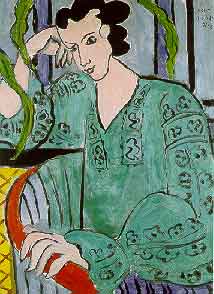
Henri Matisse, The Green Romanian Blouse
I've had a cold or flu, and have been spending quite a bit of time on the couch. Thank God for my laptop and our wireless network! And also for books. One thing I read was "Matisse and Picasso" by Francoise Gilot, who lived with Picasso for many years, is the mother of his children Claude and Paloma, and a painter and writer in her own right. Along with her book I've been looking at several comparative volumes devoted to these two giants. They were far better friends than I had realized: competitors, to be sure, but friends who always kept aware of what the other was doing, and who visited each other for long conversations. Picasso once told Gilot, "When one of us dies, the other will have no one left who understands," and indeed, Picasso was devastated by Matisse's death.
Gilot is a good writer and she has an excellent memory; she also admired Matisse enormously and got along very well with him. In contrast to Picasso, Matisse was gentle, kind, and much more secure; they were both men who loved life but certainly expressed it in different ways.
In art, truth and reality begin when you no longer understand anything you do or know and there remains in you an energy, that much stronger for being balanced by opposition, compressed, condensed. Then you must present it with the greatest humilty, completely white, pure,candid, your brain seeming empty in the spiritual state of a communicant approaching the Lord's table. You clearly must have all your acocmplishments behind you and know how to keep your instinct fresh.
Love...sustains the artist. Love is an important thing, the greatest good which alone lightens that which weighs heavy and enables to bear with an equal spirit that which is unequal. For it carries weight which without it would be a burden, and makes sweet and pleasant all that is bitter.
--Henri Matisse
10:06 PM
|
Monday, October 13, 2003
A second reason why the holiness of life is so obscured to modern Christians is the idea that the only holy place is the built church...St. Paul, preaching at Athens (said): "God that made the world and all things therein, seeing that he is lord of heaven and earth, dwelleth not in temples made with hands..." Idolatry always reduces to the worship of something "made with hands," something confined and with the terms of human work and human comprehension...(but) God is not to be fenced in, he is the wildest being in existence.
--Wendell Berry
Yesterday our parish congregation moved back into a newly renovated, added-onto church building. It is quite grand and glorious. The sanctuary itself seems more airy, lighter, and more open, and there is a new organ and lots more room for our choir in the chancel, and a big gathering room, and new offices and meeting rooms, a fine kitchen, and Sunday School rooms, all sprinkled and lighted and bright with paint.
I was on the vestry (that's the elected governing board of an Episcopal Church, made up of lay people) during the years when we were trying to decide whether to build this, and why, and how much to spend. The project was pushed forward by a priest and some wealthy parishioners whose values and theology I did not share, and at the end, I was one of two people who voted against the project. There were parts of the project I felt were very much needed, but many I thought were superfluous luxuries. With war looming in Iraq, Palestine bulldozed into ruins, American inner cities fille dwith drugs and hopelessness, and an entire African continent dying of AIDS, I felt a million and a half dollars elsewhere would represent Christ a whole lot more. I said I believed that our church needed to think about its values and purpose rather than its appearance: what were we doing to welcome others in, and what were we doing outside our own doors to alleviate suffering and hardship? Other parishioners agreed with me, and I felt it was important to represent a strong dissenting minority in the final vote.
But we have a new facility now, and I am able to celebrate it along with my friends, while mourning the wrenching times our parish went through during this period, and the good people we lost in the process. We now have a new priest-in-charge whose theology and style could not be more different from his predecessor, and a national Church that has endorsed ground-breaking inclusiveness.
Ironically, the Gospel reading yesterday was the parable of the rich young man, who is told by Jesus that what he needs to do to inherit eternal life is to sell everything he has, give his money to the poor, and follow. In a fine sermon, our priest spoke of the need to rejoice in what had been accomplished, to give thanks for all the people who had made it happen, and then to immediately begin thinking about the opportunity we are being given to use our bountiful resources of time, treasure, and talent to do God's work in the world. With his leadership, rather than clergy who set obstacles for laity with liberal visions, we are likely to be able to do that.
So today I was fascinated to find Fred's reference to a new essay by Wendell Berry, "Christianity and the Survival of Creation" - ostensibly a Christian environmentalist's call for responsibility, but actually a much larger call for renewal of Christianity in general. Berry uses the pulpit as a soapbox here, and he thunders like an Old Testament prophet - sometimes too much for his own credibility or good, in my opinion. I doubt that you'll agree with all his points; I certainly did not. But the crux of what he says is both profound and crucial, and I highly recommend it to anyone who has been turned off by Christianity's history of complicity with the Powers that Be, and their destruction of the earth and its creatures.
7:51 PM
|
Sunday, October 12, 2003
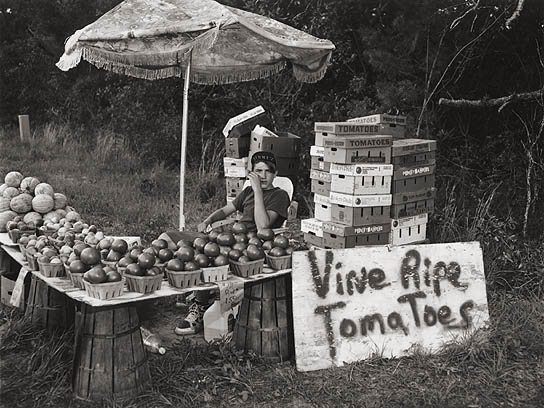
"Tomato Boy" from the series, "Fish Camp" by Carl Gillette (via consumptive.org)
... the images express humble values which some of us still hold in high regard: a simple lifestyle in rhythm with the environment where common sense is the rule of order. However fleeting, these values and the 'Old Florida' of my childhood, and my ancestors, still exists. --Carl Gillette
I'm not the photographer in the family, but if I were, I might do a series on the signs that announce homegrown vegetable stands, not to mention the stands themselves. The topic could be expanded to "lemonade" and "honey" and even "worms and crawlers", or the ubiquitous "FREE" announcing, in New England at the end of summer, a pile of large long green objects better known as zucchini.
The way we go into Canada takes us past huge flat fields where the main crop is corn. Most of the farmers grow some sweet corn as well as "cow corn", for feed, and nearly every farm has a sign announcing "mais sucre" either in words or a picture of a golden ear of corn, or both. When I was back in central New York I noticed a lot of similar signs, all handpainted, including my absolute favorite, a painting of a giant potato with two stars on either side, and the name of the farm family. No word "potato" at all.
I suppose, as someone who's always been interested in type and lettering, there's an inherent fascination with signs themselves, but the real reason I find these icons compelling is what they say about the underlying local culture. In rural areas where people feel secure with themselves and their neighbors, there's a looseness and unselfconsciousness about the signs people make. As soon as people feel they're being judged by others who have more education or more sophistication, they tend to clam up verbally, and they stifle their native expressiveness, at least in public. How sad that is! How much cultural vitality we lose in the process, and how many creative people who were never shy before find themselves tongue-tied and slack-handed when homogeneous mass culture descends with its rulebook of taste.
Around here now, we have "farmer's markets" on Saturdays - real farmers, to be sure, trucking in their perfect produce for city people to buy. They become a tourist attraction, with pumpkins and cornstalks artfully arranged: a photo opportunity. Driving through Woodstock, Vermont, recently, I could barely get through town for the busloads of leaf peepers oohing and ahhing over baskets of apples and gourds under tents on the village green. Having just come from truly rural farm country, where the symbiotic relationship between tourist/urban sophisticate and farmer does not exist, it suddenly struck me as not far from the spectacle of Maasai dancing for tour buses in Africa and offering their beaded jewelery for sale. Like the photographer, Gillette, and his pictures of rural Florida, I am aware of something that's dying, not only for economic reasons but because local people are no longer comfortable with who they are when cultures collide.
7:06 PM
|
Friday, October 10, 2003
 CASTOR CANADENSIS CASTOR CANADENSIS
I was trying to find more information about beavers today ("beaver" is, ahem, quite an interesting word to search on the internet) and came upon this concise description of beaver life. Among other facts, here's a mini-primer on beaver reproduction and development:
Beavers are monogamous usually but if one mate dies, the other will "remarry". Family groups consist of two adults, several two year olds and the young of the current year. They mate first at about three years old. Gestation is 128 days. Litters of 2 to 6 are born in April and May. Kits can swim when a few hours old; weaned at one month. The mother carries the kits in her mouth supported on her front legs while walking upright on her hind legs and tail. Young leave or are forced out of the colony by two years of age. Large lodges may have several family groups. Family life is cooperative, all help with the hard work of gathering food, building and repair.
The site also has two short video clips on beavers from the Toronto Zoo. The first one shows an orphaned baby beaver being encouraged to swim by the zookeeper, who hand-reared it.
The beaver is the official symbol of Canada, appearing on its very first postage stamp, the current 5-cent coin, and in many other stamp, coin, and heraldic contexts. The shield of the famous Hudson Bay company has at its center a cross and four beavers:
When Charles II granted the Hudson's Bay Company charter to his cousin Prince Rupert and 17 gentlemen in 1670, he asked that whenever the king visited the H.B.C. area, Prince Rupert should receive as a tribute the furs of one fox, two elk and four beavers. These seven animals make up the heraldic design.
Those of you who follow this blog may know by now that I love animals, but also love whacky animal humor. One of my favorite cartoons, by Charles Addams, showed a group of boy scouts crossing a stream - all of them with buck teeth - with the title "Beaver Patrol". Real life has also offered some bizarre beaver memories. Close to where I grew up, there was a woman known as "The Beaver Lady" whose home was built over a running stream with a beaver dam. The beavers regularly came up into her house, where she fed them. I never went there, but I knew someone who knew her, and I've seen photographs of her, in this house, with beavers sitting on her lap.
2:11 PM
|
Thursday, October 09, 2003
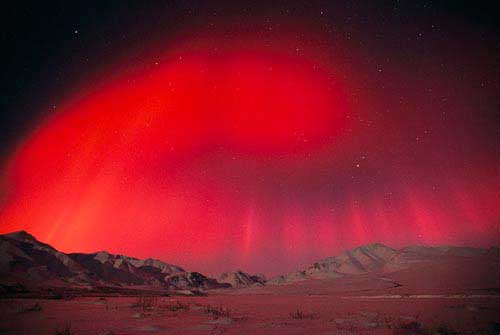
Aurora Borealis, from the Arctic Refuge Series by photographer Subhankar Banerjee (via wood s lot)
I have arctic on my mind; we're halfway through the film "The Fast Runner" and my mind is spinning with images of real people living in a way I still cannot quite imagine: a quite brutal existence of nomadic hunting, igloos, tents, clan rivalries, yapping dogs, seal meat and whale blubber, ice, fur, whiteness. Have any of you seen it? I am never going to romanticize Inuit art again. A great film: beautiful but not easy to watch.
Today I went on a small hunting expedition of my own: a late afternoon walk/clamber down to inspect the beaver dam in the river. I'm quite certain no one has been there before me. The place is quite inaccessible, at the foot of a very steep, overgrown bank, nearly impossible to reach ether from the river edge or from the road above. I decided to try the lower route first, not wanting to fall down the bank and lie there for hours with a twisted ankle, and although it was hard going, I made it through the tall grasses, the stands of wild "bamboo" and the thicket of honeysuckles and fallen branches that grew along the bank. There are tall mature trees here: the grove of thorny locusts I can see from my window here; a huge sycamore whose peeled bark lay in shreds under my feet, making a silent approach impossible.
I wanted to see if the dam was still active. As I got close, I saw fresh, green saplings laid on the top, and stalks of the thick, sharp bamboo. There were three beaver "slides", the muddy access areas the animals use to get in and out of the water, but I couldn't see any beavers. It was hot, midday, and I stepped back into the shadows under the sycamore. Then I saw movement under the water. It was a huge beaver, one of the biggest I've ever seen, swimming completely submerged in the pool above the dam. He circled warily under the surface, two, three times, brown fur glistening in the sunlight, big flat tail black and powerful. Then he disappeared beneath the bank. Had he heard my footsteps above, or sensed the vibration? Probably. I stepped away, remembering a friend who had been charged by a beaver further up the river a few years ago, and sat down near one of the slides to watch. I opened my backpack and took out an apple and ate it, thinking of my old wilderness mentor, Herm, who always advised me "never go off on an adventure without a ditty-bag". I had packed light for this journey, a block and a world away from my house: the apple, binoculars, a small sketch pad, sunglasses. But ditty-bags, Herm's army-talk for olive green, military-issue field bags with pockets and multiple uses, were as much for carrying things home as carting your lunch, field guide, and hand-lens: I rarely come home without some rocks or lichens, nuts or leaves to identify.
I decided the beaver wasn't going to reappear and headed straight up the nearly-vertical bank, hauling myself up between saplings, marveling at the depth of leaf-mould making new soil underneath the thick canopy, enjoying the dry fall warmth on my back and the sweat running down inside my shirt. I stopped and looked back down toward the dam, hidden behind the trees. "He's safe," I thought. I hope so.
3:17 PM
|
Wednesday, October 08, 2003
We always used to laugh when walking down the hall in my mother-in-law's retirement home, betting each other how far from her door we'd begin to smell the frying. She lived in a pretty wasp-y place, where hardly anyone even cooked an onion - perish the thought that you might make your neighbor's carpet smell! We're making a belated birthday dinner with J.'s family tonight, and sitting here at the computer while I take a little break from an afternoon of cooking, I can smell that familiar scent on my clothes, skin, and hair.
I rarely deep-fry anything, but on special occasions we make a few ethnic favorites. Tonight, along with grilled butterflied lamb with a mustard and rosemary marinade, I'm making eggplant slices fried in batter, and little zucchini fritters - an Armenian recipe using grated zucchini, drained and mixed with egg, a little flour, and green onion, and then fried quickly so that the strands of zucchini on the edges are brown and crispy. I love these, and tried to make them for years, until I once asked my mother-in-law to watch me and tell me what was wrong. Oh! she said. I think you're using a grater with too-small holes. That was it: the zucchini was too wet because the pieces were too small. But what recipe, oral or written, would tell you this? Some things you can only learn from a master.
Tonight there is also J.'s famous Armenian pilaf: rice cooked with vermicelli, green onions, currants, and garnished with pine nuts. Cucumbers with yogurt and mint; parsley-dominated taboulleh; and a plate of sliced tomatoes and black olives...maybe a little arak to begin...I feel old and a little incompetent when I cook these things that have always been cooked for me by an elder and an expert, and in true Middle Eastern fashion I already hear myself deprecating the food: the eggplant isn't cooked quite enough, the zucchini is a little wet, the lamb is a little overdone. In my case it may be true, and everyone will chime in with their own commentary and suggestions, but in the end the food will disappear. Wish you were here.
5:47 PM
|
Tuesday, October 07, 2003
It's a beautiful fall day here, a little on the chilly side (32 degrees when I went out for my walk early this morning). This afternoon I went out and surveyed the garden: dahlias black with frost, tomatoes on the ground, but sedum and asters blooming pluckily. I sat on a warm rock in the garden wall and ate a fresh apple, watching the red squirrel terrorize its grey cousin in a screeching, chattering chase up and down the maple trees.
Now, just after teatime, I'm working on the couch while sunlight streams in the south-facing windows of our library/living room. The gold afternoon light falls on each tiny leaf of the big rosemary plant, back indoors after a summer on the porch, and softly illuminates a bowl of velvety peaches. There's a vase of drying hydrangea blossoms, rose and off-white; the open world atlas; books on the coffee table; the worn oriental rug - and except for two boys outside, passing the house occasionally on their skateboards, it's silent here, and peaceful.
I'm getting rested, adjusting to new realities as well as resuming my routines and changing a few: I've made a fresh resolution to exercise every morning, and, inspired by my parents' immaculate housekeeping - a trait I definitely did not inherit - I'm making a pass at cleaning up some of the clutter here. It feels good to be writing and working again, and to be reading your words again, too. Thanks especially to all of you who've written with encouragement and concern for me and my family; it's very much appreciated.
5:51 PM
|
Monday, October 06, 2003
In a comment on the previous post, Miguel wrote:
"I was debating with myself whether to include one side reaction I had to your story... I don't want to say the wrong thing, but the feeling was so strong and marked. While I read of the tranquility and the richness of trees and flowers, of clear running water and birds free to come and go, I suddenly imagined what was happening in Iraq and a great sorrow overcame me. When was the last time any of us outside all that turmoil ever read anything about what a walk in the Iraqi or Afghani or other beleaguered place's countryside must be like? When do we hear of the joy in a walker there coming upon morning dew on a wildflower? There are so many places around the world crying out in pain as their inhabitants are flushed from the bushes."
I'm glad he wrote this. In fact, this very morning I said to my husband, before we got up, "Somehow I feel that the past two years have been one continuous episode, starting with September 11th. I've been unable to escape the sense of being surrounded by suffering, and it doesn't really matter if it's personal or on a world scale."
Thinking of what Miguel wrote, I'm reminded of the fact that what we hear of other cultures tends to be filtered through a political lens. It's rare, except in blogs, to read of a person's own ways of coping, the shape of daily life, the ways of finding comfort and solace in the midst of great difficulty. I think we can count on humans being human, though. Food, sex, companionship, nature, beauty, music, color: these are all universal ways of preserving life despite external circumstance. One reason I like Iranian film so much is that it shows glimpses of beauty -- a flower in a vase, a spot of bright color, a spontaneous song -- and this reassures me that people everywhere are alike. In fact, I sometimes think we are the aberrant ones, thinking that technology and money can fix every problem or deficiency, and losing the ability to find solace in nature, realtionship, and simple living. My friend in China wrote once that older people in her culture "sometimes say things were better during the years of hardship". By that she meant that the new focus on technology, financial success, and upward mobility has obscured and changed basic values and family relationships, and has failed to create greater happiness. We are so much further along that path, but I don't think it's too late to think about these questions from an individual perspective.
7:50 PM
|
Sunday, October 05, 2003
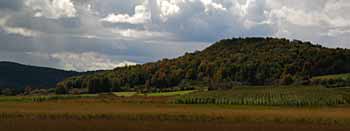
There's a good discussion going on over at Ecotone about "Ancestral Place" - what is it, does it still exist, and did the recent group of place blogger contributions actually address the topic or not? In our transient contemporary society, how does "place" figure in our sense of identity - if at all?
I know I'm unusual in that I've only lived in two places in my whole life: the central region of New York State, and this general area of Vermont and New Hampshire. I've lived in only five different houses in my 50+ years, counting one Ithaca apartment but not my dorm rooms. Well, there were a few sojourns with various boyfriends in different places, but the "permanent" residences only number five. My childhood was divided between a house in a small town and the house on the lake where my parents still live. And for the past 24 years, I've lived in the house from which I'm writing now.
That's neither good nor bad; I refuse to assign any superior value either to staying put or moving around. But where we fall on that scale of stationary or transient does affect us, and it affects the degree to which a particular place figures in our sense of personal identity. (Of course, there are people who stay in one place all their lives and never think much about it.)
In writing to the topic of "Ancestral Place", then, what do we really mean by that term? My family came originally from England, but so long ago that my idea of "roots" is here, on this side of the Atlantic, and in that corridor between the early New England colonies and the "frontier" of central New York where my family eventually settlted.
In travelling to England over the years, I've definitely felt at home in ways I don't always here, but that is cultural, not physical: my female forebears kept alive a certain sense of connection through their interest in books and the book arts, history, gardening, music and art, Anglicanism. If anything, I'm the one who has stepped outside that pattern. But my rootedness to a particular physical place is very much centered beneath my feet and on the horizon - a horizon that is lower and more rolling than the one I see outside my New England window. I wonder, though, if I'd feel as connected if my family hadn't been in love with the land and the creatures and plants, hadn't talked about it as a living thing, hadn't told stories of the old farm or my circuit-riding preacher grandfather, hadn't felt completely contented right there. Except for one cousin, I'm the only person on the maternal side of my extended family who has left a ten-mile radius of upstate New York.
Living with someone who feels rooted in this place, but who comes from a totally different culture, has been wildly expanding for me. He's travelled more than I have, but together we've gone many places and I feel comfortable in situations I never would have imagined, growing up where I did.
Without this perspective, I'm not sure I could look back at the place I came from and write anything coherent about it other than description. Before the past two weeks, I hadn't spent as long a time there
in many years, and it got me thinking about the way a place seeps into your bone marrow and flows in your blood, largely unseen and unfelt until you face it again with a gasp of recognition: yourself, reflected in a mirror of water, land, sky.
5:24 PM
|
Spam Filter Enabled:
I've had it with 100+ spam emails per day, so I just put a spam filter on my e-mail accounts. Mail sent to me via this blog should get delivered without a problem, but if by any chance you do have trouble and receive a "challenge", please either reply to it or send me a note in the comments. Everyone who is in my address book already will be passed through without question, and, as I said, new mail from readers of this blog should NOT be subjected to a filter. If you are, please let me know.
4:34 PM
|
Saturday, October 04, 2003
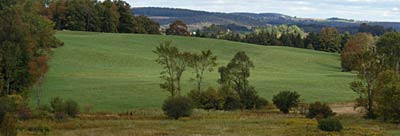
This post is a very belated contribution to the recent Ecotone topic, Ancestral Place.
I’m back home in New England, and in that transition period that feels like twilight, half here and half there, my head filled with vivid comparative impressions of two places and two lives: myself as a child and young woman, myself as I am now.
This has been a very intense week and a half for me and for my family. If it’s possible, we all got to know each other better, and became even closer. I’m reluctant to write too much about any of the personal details, but I have thought a great deal about “place” during this time: how that particular place on earth where I grew up, and where some of my ancestors have lived for centuries, formed and shaped me -- and how deeply I carry it with me despite time and distance.
During the worst, most frightening and uncontrollable recent moments, I realized the land was steadying me. The Cooperstown hospital is set into one of the loveliest glacial valleys imaginable, at the foot of Otsego Lake, a long ”finger lake” much like the ones further west in the state. Fall was just beginning to come, with a branch of red here and there among the maples, and the air was crisp and cool, the night skies as I walked back from the hospital brilliant with stars.

Standing one evening on the edge of a field while J. took some pictures, I noticed the rocks scattered every inch or two in the dark, plowed topsoil – rounded rocks, grey, an inch to three or four in diameter, so integrated with the soil as to be part of it. Glacial till. I smiled, realizing I hadn’t seen anything like this in Vermont or New Hampshire, and yet how familiar it was. Glaciers shaped these low hills and valleys, dug the lakes, made the ridges where tertiary roads run, hugging the sides of the hills. The terrain has a particular shape and form that I associate with “home”, and have never seen anywhere else. Other landscapes have more grandeur and drama, but none has ever struck me as more beautiful.
Back at my parents’ home, about forty miles west, we talked about the difficulty they’ve had keeping the lake level low this year. A few weeks ago, some of the men finally discovered that the lake outlet had been dammed by a beaver. Yesterday afternoon I walked over to check out the dam. I went through the woods across the road and couldn't believe how much they had grown up in 25 years. You cross a fence line and break out into a beautiful meadow that right now is planted with clover - it was corn the last time I was there. I followed along the outlet – the stream flowing form the lake to the river - walking in the furrows. A lot of deer had been there before me - there were sharp pointed hoof tracks in the mud and I found myself trying not to walk on top of them, I liked seeing them so much. Then the outlet became a swamp, and almost a pond above the beaver dam, which was close to the river, a very smart spot just before the old culvert and above a grove of willows. There was water flowing over it pretty strongly since the dam had been knocked down, but I saw a freshly-chewed tree, so I think the beaver is still around. I loved it - there were frogs and minnows and a lot of bright yellow-green duckweed, and I wanted to just sit down and watch for a few hours. And it was wonderful being there again. I used to walk through these woods and over to the river when I needed to get away and clear my head. The field is always breezy and quiet, with a few big hickory trees in one spot, and the woods between you and civilization. You’re alone with nature, and in a place that few people ever come to.
From the dam you can walk right over to the river. I saw a deer path and followed it and there was a whole "wallow" where the deer had knocked down all the grasses and laid down to sleep. I also saw muskrat holes in the bank and surprised a mallard who flew off down the river a little ways. When I saw the river I realized I've had a dream of this exact spot many times over the years. It's pretty fast there but shallow, with long grasses trailing off the sandy bottom, like tresses of emerald hair in the current. It’s nothing like the river near my own home at all, flowing through a field rather than rocks: everything about the geology is different, not to mention the lack of people and suburban sensibilities.

Yesterday, coming back from the nearby college bookstore, I watched the cows coming home at Red Gate farm. Mom says the farmer, who came down here from Canada, has about 600 head. There are black-and-white Holsteins, brown-and-white Holsteins, Jerseys and Guernseys, and they were all making their way back across that big field just above the lake to the barn for their afternoon milking. It was nice to see them -- their big dumb faces and lumbering gait and swaying swollen udders -- and thinking about how they do this every single day made me feel calm. That’s the comfort of real rural existence. The land lies under everything: underneath time, under your days, under the seasons. Rocks, trees, wildflowers, the deer and the coyote, the heron and goose, the horse and cow and goat and the man and woman who care for them all have their place and their role. I grew up this way, even though I gardened rather than farmed as my ancestors had done, and it still makes sense to me: a woman with her laptop, speeding between worlds.
8:50 PM
|
|
|